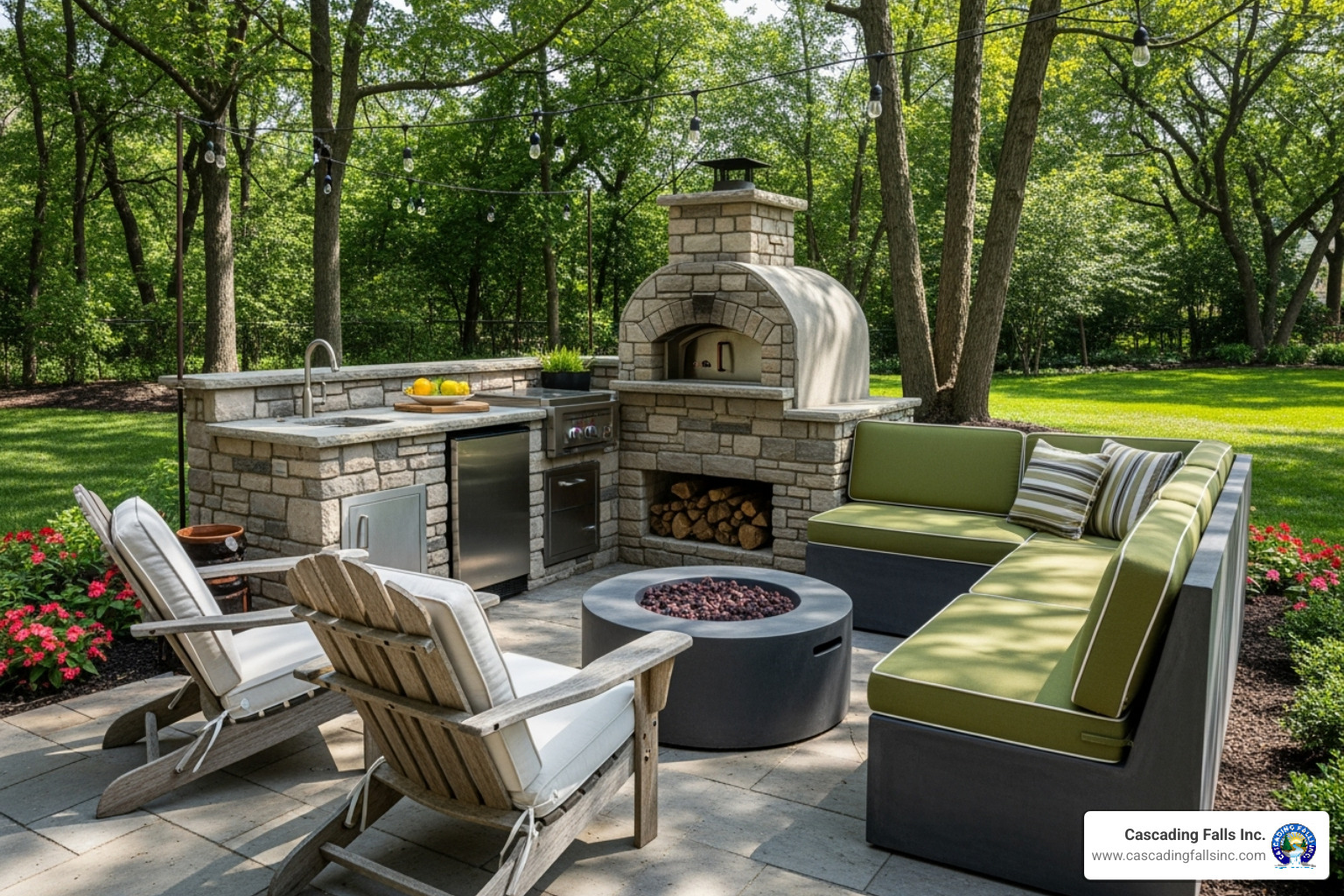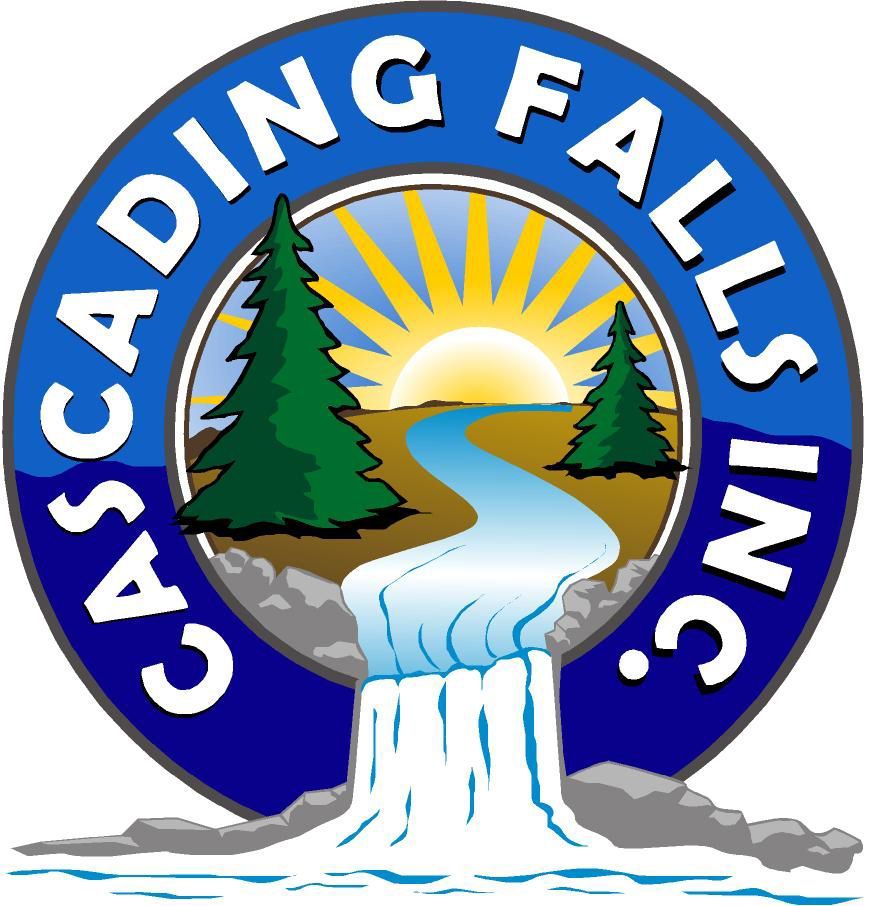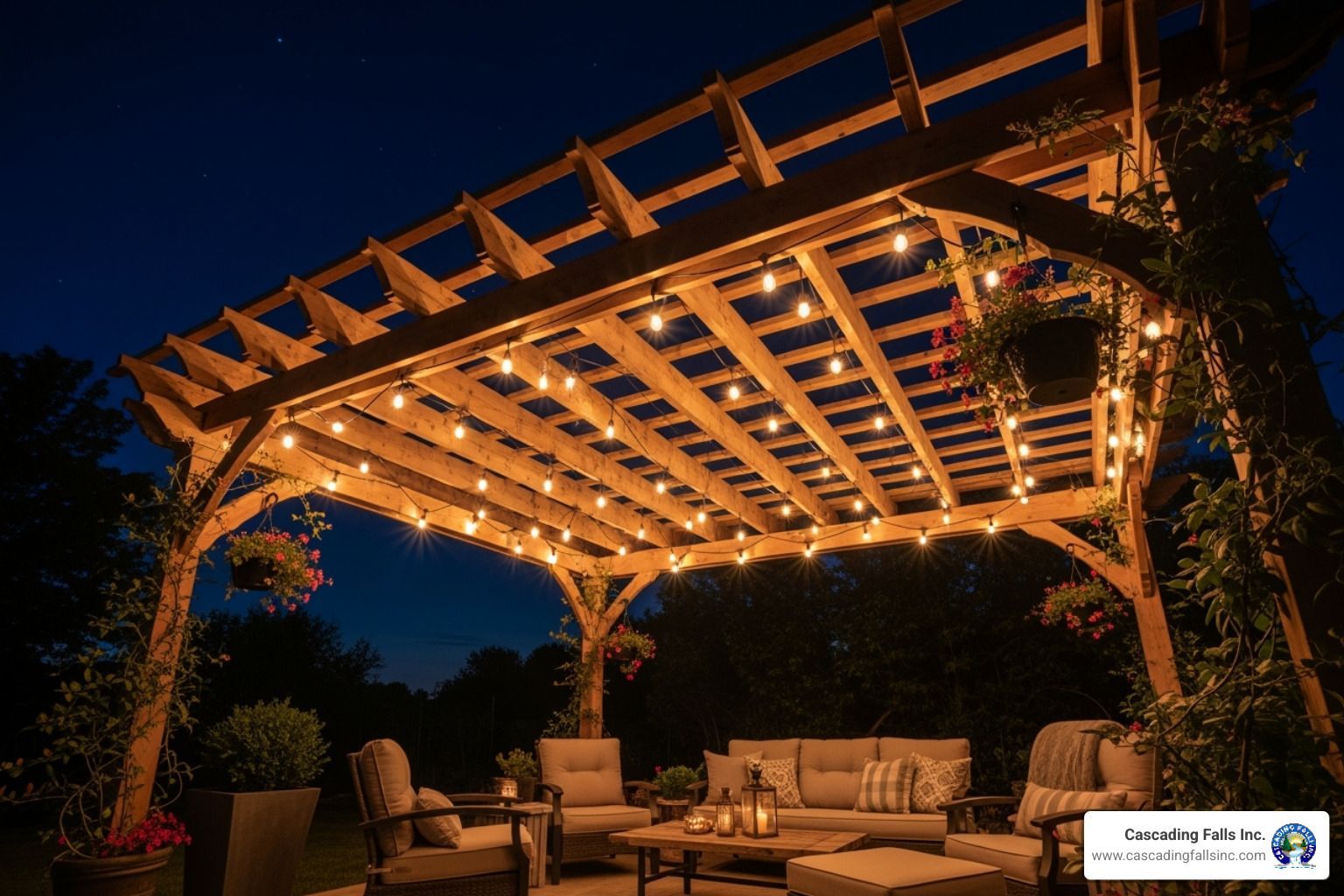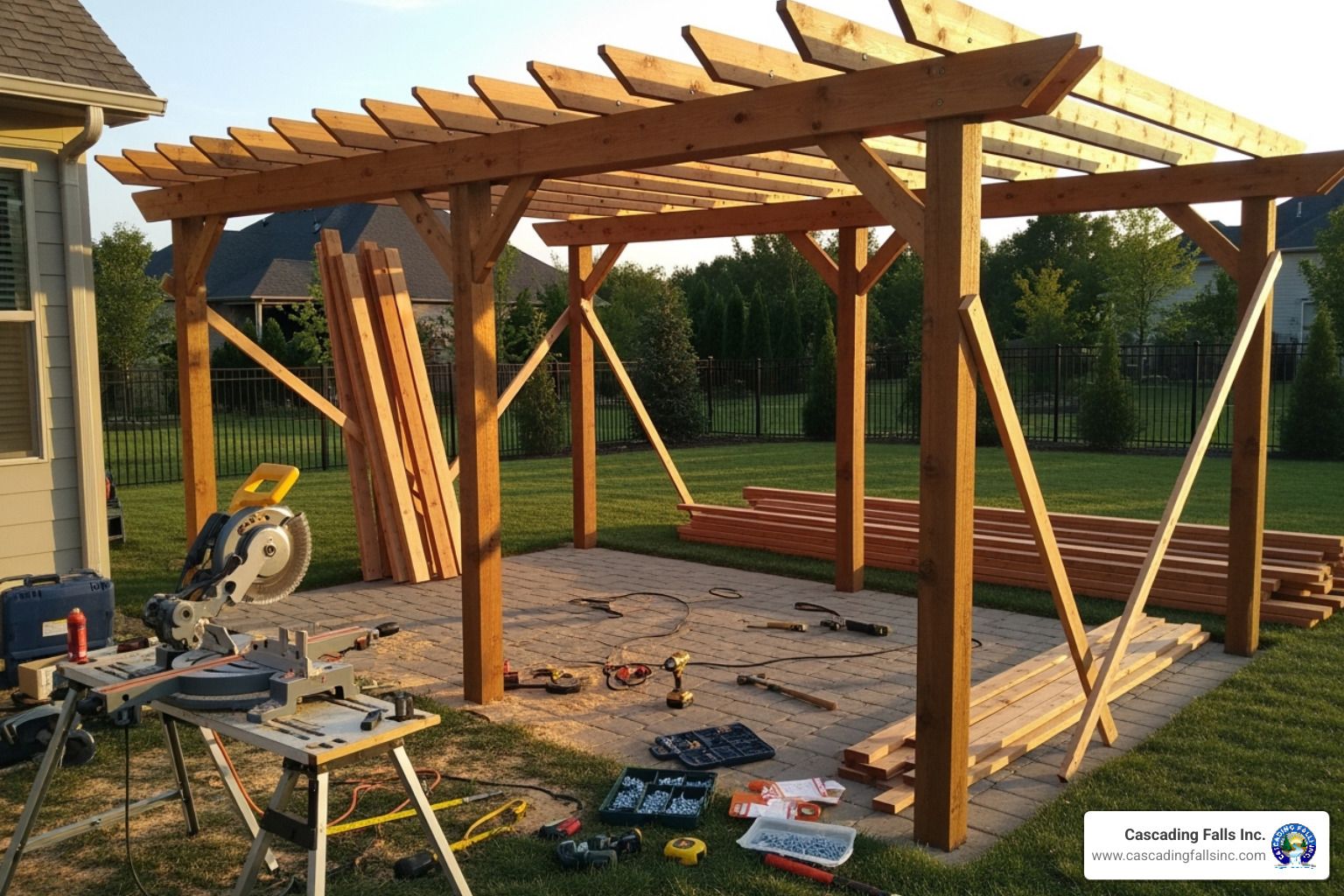Transform Your Backyard into an Entertainment Hub
DIY outdoor kitchen ideas can completely transform your backyard into the ultimate entertainment space while adding significant value to your home. Whether you're dreaming of intimate family dinners under the stars or hosting summer barbecues with friends, building your own outdoor kitchen is more achievable than you might think.
Top DIY Outdoor Kitchen Ideas by Budget:
- Under $1,000: Pallet kitchen with concrete countertops, portable rolling cart setup
- $1,000-$3,000: Basic stone-covered grill island with storage, repurposed cabinet kitchen
- $3,000-$5,000: L-shaped kitchen with sink and mini-fridge, pizza oven integration
- $5,000+: Full outdoor kitchen with covered dining area, professional appliances
As one homeowner shared after completing their DIY project: "My family will spend lots of time out there. Fabulous outdoor kitchen!" The satisfaction of building something yourself, combined with the 20-30% increase in home value that outdoor kitchens typically provide, makes this one of the most rewarding DIY projects you can tackle.
Building an outdoor kitchen doesn't require professional contractor skills - just careful planning, the right materials, and patience. From simple weekend projects using reclaimed pallets to more ambitious builds featuring pizza ovens and full plumbing, there's a solution for every skill level and budget.
I'm David Shellu, and with nearly two decades of hands-on construction and landscape experience, I've helped countless homeowners bring their DIY outdoor kitchen ideas to life through quality craftsmanship and practical design solutions. Whether you're planning a simple grill surround or a complete outdoor culinary paradise, the key is starting with a solid plan and choosing materials that can withstand your local climate.
Planning and Designing Your Outdoor Oasis
The excitement of building your own outdoor kitchen can make us want to jump straight into construction, but the secret to any successful DIY outdoor kitchen ideas project lies in thoughtful planning and smart design. Think of this as creating an outdoor room where cooking, dining, and entertaining flow together naturally.
Just like your indoor kitchen, an outdoor cooking space works best when it follows the kitchen work triangle – that efficient path between your grill, prep area, and storage. Even in smaller backyards, you can achieve surprising functionality with clever design choices.
For compact spaces, consider a single countertop with a built-in grill and fold-down prep surfaces, or invest in a rolling cart that can move wherever you need it. Larger backyards open up exciting possibilities like L-shaped or U-shaped layouts that create distinct zones for cooking, prepping, and socializing. Picture yourself grilling dinner while friends gather around a built-in bar counter – that's the magic we're aiming for!
Before breaking ground, there's one crucial step many DIYers overlook: checking local building codes and permits. While a portable setup might fly under the radar, permanent structures involving gas, plumbing, or electrical work almost certainly need approval. These regulations vary widely, so a quick call to your local planning department can save you major headaches down the road. They'll have specific rules about setbacks from property lines, ventilation requirements, and structure sizes that don't require permits. To get a general understanding of what these entail, you can review resources like the International Residential Code , which many local codes are based on.
For complex projects that integrate hardscaping and outdoor living elements, the experienced team at Cascading Falls Inc. can provide expert guidance through the entire process. More info about landscaping services.
Planning Your DIY Outdoor Kitchen Ideas
Let's explore the key decisions that will shape your DIY outdoor kitchen ideas project:
Assessing your available space comes first. Measure your backyard thoroughly and note existing features like patios, decks, or mature trees that could become part of your design. Think about traffic flow – you'll want plenty of room for movement between cooking, dining, and seating areas without creating bottlenecks.
Setting a realistic budget is where DIY projects really shine, since you'll save thousands on labor costs. A basic outdoor kitchen island frame might start around $800 (before appliances and finishes), but total costs vary dramatically based on your choices. Professional installation of plumbing, gas lines, and electrical work can each add several hundred dollars – and these are areas where safety absolutely requires expert help.
Choosing the perfect location involves more than just picking a pretty spot. Proximity to your house makes a huge difference, both for utility connections and for shuttling food and supplies back and forth. The closer you build, the easier (and cheaper) it becomes to run necessary lines.
Consider your existing utility lines carefully. Minimizing new runs saves serious money. A propane grill with a tank eliminates the need for a gas line extension, while an ice chest can replace an expensive mini-fridge installation. Solar-powered lighting offers beautiful illumination without any electrical work.
Don't forget about sun and wind exposure. Pay attention to prevailing wind direction so smoke doesn't blow toward your cooking or seating areas. Think about the sun's path throughout the day – do you prefer morning sun for breakfast or afternoon shade for dinner parties? A pergola or gazebo can provide welcome protection from the elements while extending your kitchen's usability through different seasons.
DIY vs. Hiring a Professional
The choice between going DIY or hiring professionals depends on your budget, available time, skill level, and comfort with complex tasks. Here's how the options compare:
| Factor | DIY Outdoor Kitchen Project | Hiring a Professional |
|---|---|---|
| Cost | Significantly lower upfront costs, save on labor, but may need professional help for utilities | Higher upfront investment, but includes expertise and warranty coverage |
| Time | Flexible timeline, work at your own pace, but projects often take longer than expected | Faster completion with dedicated crews and established workflows |
| Customization | Complete creative control, can modify plans as you build, perfect for unique visions | Professional design input, but may have limitations based on standard practices |
| Skill Required | Basic carpentry and construction knowledge needed, steep learning curve for beginners | No personal skills required, but less hands-on learning experience |
For ambitious projects requiring complex hardscaping, patios, or professional-grade construction, Cascading Falls Inc. brings the expertise to turn your ultimate backyard vision into reality with their "Whatever It Takes" commitment to quality and customer satisfaction.
The beauty of DIY outdoor kitchen ideas is that you can start simple and expand over time. Many homeowners begin with a basic grill island and add features like sinks, storage, or seating areas in future phases as their budget and confidence grow.
Choosing Budget-Friendly and Durable Materials
When it comes to DIY outdoor kitchen ideas, choosing the right materials can make or break both your budget and your project's longevity. The key is finding that sweet spot where affordability meets durability – because nobody wants to rebuild their dream kitchen after just one season!
Let's start with the foundation: countertop materials. Concrete countertops are absolute champions in the outdoor kitchen world. They're incredibly durable, weather-resistant, and surprisingly budget-friendly if you're willing to pour them yourself. You can cast them in place or create slabs and install them later. The best part? Concrete can handle everything Mother Nature throws at it while giving you that sleek, modern look.
Tile countertops offer another fantastic budget option, especially if you can score some leftover tiles or find deals online. Just make sure you're using outdoor-rated, frost-proof tiles – trust me, regular indoor tiles will crack faster than you can say "winter freeze." The variety of styles available means you can create anything from rustic charm to contemporary elegance.
For the framing materials, pressure-treated wood remains the go-to choice for most DIY enthusiasts. It's cost-effective, readily available, and specifically designed to resist rot and weather damage. If you're looking for something even more durable (and don't mind spending a bit more), steel studs offer excellent longevity and won't warp or twist over time.
Now, here's where creativity really pays off with finishing materials. Stucco provides an affordable and durable exterior finish that can transform a basic frame into something that looks professionally built. For those wanting a more upscale appearance, durable stone veneer options from our landscaping services can give you that high-end look without the high-end price tag.
Reclaimed wood and repurposed pallets deserve special mention here. These materials can dramatically slash your costs while adding unique character to your outdoor kitchen. I've seen amazing changes where old barn wood or properly treated pallets became the star of the show. Just remember to sand everything smooth and apply proper weatherproofing – splinters and outdoor cooking don't mix well!
Essential Components for Your Outdoor Kitchen
Every successful outdoor kitchen, regardless of budget, needs certain core components to function properly. Think of these as the non-negotiables that separate a true outdoor kitchen from just "a grill on the patio."
Your grill is obviously the heart of the operation. Whether you choose a built-in gas model, a classic charcoal setup, or even a versatile kamado-style cooker, this is where the magic happens. Built-in grills create a seamless look, while freestanding models offer more flexibility and easier replacement down the road.
Prep space might seem obvious, but you'd be surprised how many people underestimate how much counter area they actually need. You'll want room for raw ingredients, finished dishes, and everything in between. A good rule of thumb is to plan for more space than you think you need – you'll use every inch of it during your first big cookout.
Storage solutions are where many DIY projects fall short, but they're absolutely crucial for a functional outdoor kitchen. You need somewhere for utensils, cleaning supplies, propane tanks, and all those little things that make outdoor cooking enjoyable. This can range from simple open shelving to weatherproof cabinets, depending on your budget and ambitions.
An outdoor refrigerator or even a simple drop-in cooler eliminates those constant trips back to the house. Nothing kills the outdoor cooking vibe like having to dash inside every time you need a cold drink or forgot an ingredient.
Sink options can range from a simple garden hose connection with a drain bucket (surprisingly effective for basic needs) to a full plumbing setup with hot and cold running water. The simple approach works great for washing hands and rinsing vegetables, while the full setup transforms your outdoor kitchen into a true second kitchen.
Weatherproofing and Maintenance
Here's the truth about outdoor kitchens: they're going to face everything from blazing summer sun to winter storms, and your material choices need to reflect that reality.
Protective covers are your first line of defense and probably the best investment you'll make after the kitchen itself. Quality covers protect your grill, appliances, and even the entire kitchen island when not in use. Think of them as insurance policies for your investment.
Sealants for wood and concrete aren't optional – they're essential. Wood components need regular treatment with penetrating sealers or exterior stains to prevent rot and UV damage. Concrete countertops benefit from breathable sealers that protect against stains and freeze-thaw cycles while still allowing moisture to escape.
Low-maintenance materials should be your best friends in this project. Stainless steel appliances resist rust and corrosion while looking great year after year. They might cost a bit more upfront, but they'll save you headaches and replacement costs down the road.
Regular cleaning tips are simpler than you might think. A mild soap and water solution handles most cleaning tasks. For your grill, clean the grates after each use and follow the manufacturer's guidelines for deep cleaning. The key is staying on top of maintenance rather than letting problems build up.
A little prevention goes a long way. Check periodically for loose components, signs of wear, or small issues that can become big problems if ignored. In colder climates, winterizing your plumbing and storing portable appliances indoors will extend their life significantly.
Creative DIY Outdoor Kitchen Ideas for Every Style
Now for the fun part: releaseing our creativity! DIY outdoor kitchen ideas offer endless possibilities to craft a space that truly reflects our style and needs. The beauty of building our own outdoor kitchen lies in the freedom to experiment with unique designs that perfectly match our vision and budget.

The most inspiring outdoor kitchens often come from thinking outside the box. Take The Pallet Kitchen approach – entire cooking stations built from repurposed wooden pallets that cost practically nothing but deliver rustic charm in spades. We can create everything from the frame to shelving using these versatile materials, then finish with a weathered stain for that perfect farmhouse look.
For those with a bit more space to work with, The Pizza Oven Paradise transforms any backyard into an Italian-inspired retreat. Building a wood-fired pizza oven as the centerpiece creates an incredible focal point and offers interactive cooking experiences that guests absolutely love. We can construct a sturdy brick or stone base and surround it with prep counters for the ultimate outdoor cooking experience.
The Repurposed Cabinet Kitchen gives new life to old indoor kitchen cabinets. With proper exterior paint and weatherproofing, these become instant storage solutions that look surprisingly polished. It's amazing what a coat of weather-resistant paint can do to transform something destined for the landfill into a functional outdoor kitchen component.
Budget-Friendly DIY Outdoor Kitchen Ideas
Creating an impressive outdoor kitchen doesn't require breaking the bank. The key is embracing resourcefulness and getting creative with materials we already have or can source inexpensively.
Upcycling furniture opens up incredible possibilities. That vintage dresser gathering dust in the garage? It can become a charming outdoor buffet or storage unit with some sanding and exterior stain. Old kitchen cabinets, properly sealed and painted with exterior-grade products, can form the foundation of our kitchen island while providing valuable storage space.
Using leftover construction materials is where real savings happen. Before purchasing anything new, we should check local marketplaces, salvage yards, or even our own garage for leftover fence panels, wood scraps, bricks, or tiles from previous projects. One clever homeowner built an entire outdoor kitchen for just over $250 using such materials – that's thousands less than professional quotes!
A simple grill surround offers big visual impact without extensive construction. Instead of building a full island, we can create a clean, finished look around our freestanding grill using concrete blocks, bricks, or a basic timber frame. This approach provides some counter space and storage while keeping the project manageable for weekend DIYers.
Open shelving beats expensive cabinets every time when we're watching the budget. Simple metal brackets supporting reclaimed wood shelves cost a fraction of custom cabinetry while adding rustic or industrial charm. Plus, they're much easier to install and maintain than enclosed cabinets.
Integrating Seating and Dining Areas
The magic happens when our outdoor kitchen becomes more than just a cooking space – it becomes the heart of outdoor entertaining. Smart seating and dining integration transforms a simple grill setup into a true gathering place.
A bar-height countertop with stools creates the perfect social hub. Extending our kitchen counter to comfortable bar height gives guests a front-row seat to the cooking action. There's something special about having friends perched nearby, cold drinks in hand, while we work our grilling magic. It keeps everyone engaged and conversation flowing naturally.
Built-in benches offer a more permanent solution that can really tie the whole space together. We can construct these using the same materials as our kitchen island – whether that's wood, concrete blocks, or stone – creating a cohesive look that feels intentionally designed. Add some weather-resistant cushions and throw pillows, and suddenly we have comfortable seating that doubles as extra storage underneath.
For the simplest approach, an adjacent patio dining set clearly defines separate cooking and eating zones while keeping food easily accessible. A sturdy picnic table works beautifully for casual family meals and fits almost any budget.
Creating distinct zones makes even compact spaces feel larger and more functional. An L-shaped kitchen naturally separates the active grilling area from a relaxed serving or bar zone. We can use outdoor rugs, different paving materials, or even planters to subtly define these different areas without walls or barriers.
The ultimate touch? Fire pit integration within the seating area extends the usability of our outdoor space well into cooler evenings. There's nothing quite like the warm glow of a fire to keep conversations going long after dinner is finished, creating those memorable moments that make all our DIY efforts worthwhile.
Frequently Asked Questions about DIY Outdoor Kitchens
We've covered a lot of ground, but some questions keep popping up whenever homeowners start dreaming about their perfect outdoor cooking space. Let's explore the most common concerns about DIY outdoor kitchen ideas and give you the straight answers you need.
How much does a DIY outdoor kitchen typically cost?
Here's where the DIY approach really shines - you can create something amazing without breaking the bank. A basic island frame can start around $800, not including appliances or finishes. DIY projects save significantly on labor, but costs for plumbing, gas, and electrical lines can add several hundred dollars each.
The real numbers might surprise you. One clever homeowner built their entire outdoor kitchen for just over $2,300, while professional quotes came in around $14,000. That's serious savings! However, don't forget to budget for the fun stuff - your grill, countertops, and any appliances you're dreaming about.
Utility connections are where costs can creep up. Installing plumbing lines, running gas for that built-in grill, or adding electrical outlets typically requires professional help (and we strongly recommend it for safety). Each utility can cost hundreds of dollars, but they transform your basic setup into a truly functional outdoor kitchen.
Overall, expect to spend anywhere from $1,000 to $5,000 for a solid, functional DIY outdoor kitchen depending on your material choices and how fancy you want to get. Adding features like sinks, mini-fridges, or elaborate stone finishes will bump up the price, but you're still looking at massive savings compared to hiring professionals for the entire project.
How can I build an outdoor kitchen in a small space?
Small spaces don't mean small dreams! Focus on vertical storage, use a rolling cart for flexibility, or build a single-wall kitchen along a fence or wall. L-shaped designs can also work well in corners to maximize space.
The key is getting creative with every square inch. Vertical storage is your best friend- think shelves, hooks, and magnetic strips mounted on walls or the back of your kitchen island. This keeps your precious counter space clear for actual cooking.
Rolling carts are absolute game-changers for tight spaces. You can wheel out a fully equipped cooking station when it's party time, then roll it back against a wall or into storage when you need your patio space back. It's like having a kitchen that appears and disappears on command!
Single-wall kitchens work beautifully along fences or walls, creating a streamlined look that doesn't overwhelm your space. If you're blessed with a corner, an L-shaped design can actually feel more spacious than you'd expect, giving you distinct zones for cooking and socializing.
Don't forget about fold-down surfaces- countertops that extend when you need extra prep space and fold away when you don't. It's like having a kitchen that grows and shrinks based on your needs.
How do you add a sink to a DIY outdoor kitchen?
Adding a sink transforms your outdoor kitchen from good to absolutely fantastic. A simple solution is connecting a garden hose to a faucet with a drain bucket below. For hot and cold running water, you will need to hire a licensed plumber to run permanent water lines, which is the safest option.
The garden hose and bucket approach is surprisingly effective for basic needs. Connect an old kitchen faucet to your garden hose, position a large bucket underneath for wastewater, and you've got instant hand-washing and light cleanup capability. You'll need to empty the bucket occasionally, but it's a great starting point that costs almost nothing.
For the full experience with hot and cold running water, you'll want to call in the professionals. Running permanent water lines, connecting to your home's drainage system, and ensuring everything meets local building codes requires expertise that most DIYers don't possess. This is one area where the investment in professional installation pays off in convenience, safety, and peace of mind.
A gravity-fed system offers a nice middle ground - set up a water tank liftd above your sink area, and gravity does the work. You can even add a small water heater for warm water. It's more involved than the hose method but doesn't require major plumbing work.
Conclusion
Building your own outdoor kitchen is one of the most rewarding journeys you can start on as a homeowner. It's so much more than just creating a place to grill burgers – you're crafting a space where project satisfaction becomes deeply personal, where every meal cooked outdoors feels like a small victory, and where the simple act of flipping pancakes on a Sunday morning takes on new meaning.
The magic really happens when you realize how much this project can transform your daily life. Enhancing your lifestyle isn't just marketing speak – it's the genuine joy of stepping outside with your morning coffee to prep vegetables in the fresh air, or the convenience of having everything you need right at your fingertips during a dinner party. No more running back and forth to the indoor kitchen, missing conversations and moments with your guests.
But perhaps the most beautiful part is creating memories that will last a lifetime. Picture your kids learning to flip their first pancake on the outdoor griddle you built with your own hands, or hosting that perfect summer evening where everything just clicks – the food, the company, the warm glow of string lights overhead. These moments happen naturally when you have a space designed for gathering and sharing.
The DIY outdoor kitchen ideas we've explored together – from simple pallet constructions to elaborate pizza oven setups – prove that there's a solution for every budget, skill level, and space. Whether you spent $800 on a basic frame or invested in a more comprehensive setup, the pride of knowing "I built this myself" never gets old.
Of course, not every project needs to be a solo trip. For ambitious projects that integrate complex hardscaping, patios, or require professional-grade construction, the expert team at Cascading Falls Inc. can bring your ultimate backyard vision to life. Our "Whatever It Takes..." approach means we're committed to turning your dreams into reality with best craftsmanship and attention to detail.
Ready to transform your backyard into the outdoor living space you've always imagined? Start planning your dream backyard today and let's create something amazing together.





